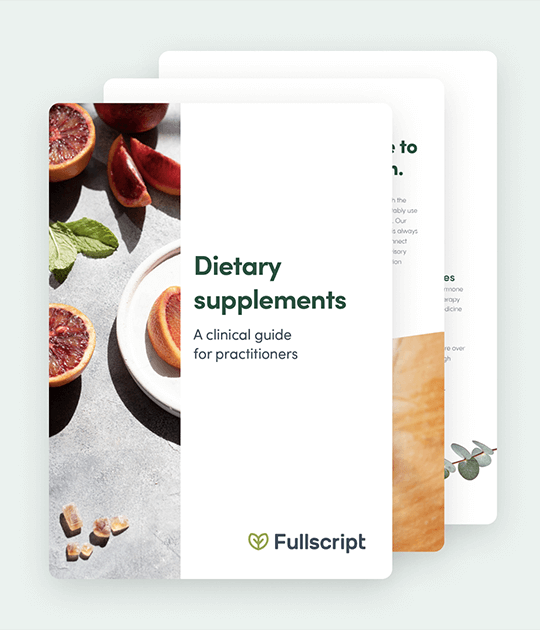What are amino acids?
Amino acids are the building blocks of protein, and since your body is made of protein, you need amino acids. Amino acids are generally divided into three major categories: essential, non-essential, and conditionally essential. Essential amino acids (histidine, isoleucine, leucine, lysine, methionine, phenylalanine, threonine, tryptophan, and valine) must be obtained through the diet and cannot be synthesized in the body. Non-essential amino acids (alanine, aspartate, asparagine, arginine, cysteine, glutamate, glutamine, glycine, proline, serine, and tyrosine) are produced by the body and don’t have to be consumed from food or supplements. Some of these non-essential amino acids (arginine, cysteine, glutamine, tyrosine, glycine, proline, and serine) are considered “conditionally essential” in cases of illness or chronic conditions. Tyrosine, for example, is conditionally essential for individuals with a condition known as phenylketonuria, because they cannot synthesize it on their own. In those cases, tyrosine needs to be consumed from foods or as a supplement. (1)(26) Amino acids are often associated with muscle growth and exercise performance, but they are also critical to neurotransmitter activity in the brain, enzymes that process nutrients, and immune defense. (21)(24)(26)(41)(43)What is d,l-phenylalanine (DLPA)?
Because of their importance, amino acids are used in supplements in combination or as supplemental ingredients on their own. One example of this is the combination of the D- and L-forms of phenylalanine, commonly known as DLPA. L-phenylalanine is the natural form of the essential amino acid found in food. D-phenylalanine is a synthesized, mirror image of the L (“levo” or left) form, in that it is structured to the right, or “dextro” side. DLPA is a 50/50 combination of the two. (25)
Studies indicate that DLPA may offer pain relief and improve mood.
DLPA benefits
DLPA may be beneficial in addressing pain as well as supporting immune function and addressing conditions such as depression and vitiligo.Pain relief
DLPA is especially important in clinical use because of the synergistic properties of the combination. The “L” form improves mood-elevating chemicals in the brain, such as dopamine, epinephrine and norepinephrine. The “D” form of phenylalanine blocks an enzyme known as enzyme carboxypeptidase A, that intensifies the feelings of pain. (13)(14)(34) The combination of the two amino acids also blocks the activity of another enzyme called enkephalinase. This stops the degradation of one of the brain’s natural pain-killing substances, enkephalins, which belong to the same family as endorphins. Enkephalins promote the body’s own analgesic (pain relief) response and improve mood. (34) The interest in DLPA for pain relief goes back several decades when researchers were untangling the various ways that amino acids activate and interact with receptors in the body. In some animal and human studies, it was used as an adjunct therapy to bolster the positive effects of acupuncture. (10)(14) Research posited that DLPA works in close partnership with the body’s own endogenous analgesia system (EAS). This pathway extends from neurons in the medulla oblongata all along the dorsal horns of the spinal column, so it is intricately bound together with autonomic responses, including pain signaling. The EAS reduces the activation of pain reception along that pathway, and it is powered, in part, by enkephalin activity. (34)Depression and mood
Aside from pain relief, the potential of DLPA in combination, or as its constituent amino acid components, has been noted in research regarding depression treatment. Early research with DLPA found that it reduced agitation, feelings of sluggishness, and depressed mood in patients diagnosed with depression in a relatively short period of time, 20 days. The result was that 12 of the 20 patients could be discharged without further treatment. (8) In a later clinical study, DLPA and d-phenylalanine helped address unipolar depression. Researchers reported that in a short period of time, a majority of patients (17 of 23), experienced a complete sense of emotional stability and equanimity, with no observed adverse reactions. One study participant achieved these results after one day of use. In this particular study, the DLPA form required only half the dose of the single d-phenylalanine form, so there appears to be a synergy at work with the combination of the two. (15) In other clinical research, DLPA was compared to imipramine, a tricyclic antidepressant. Both were deemed equivalent by the end of the 30-day trial period, although the drug showed stronger anti-anxiety effects early on. However, given the potential side effects of imipramine, which include drowsiness, stomach cramps, diarrhea, dry mouth, and weight gain, DLPA may be preferred by integrative practitioners and their patients. (7) Used separately from its d-form counterpart, l-phenylalanine has been used in conjunction with deprenyl, a monoamine oxidase inhibitor, in clinical research of patients with depression. The combination of the two was effective in 90% of outpatients and 80.5% of inpatients. (10) Additionally, in cases of depression caused by chronic inflammation, there is research linking levels of phenylalanine, tyrosine, and tryptophan to the progression, intensity, and treatment of the condition. (38)Immune function
D-amino acids have also been investigated for their roles in the inhibition of bacterial growth. The biomechanics are still being investigated, but one laboratory study found that D-phenylalanine was one of the strongest amino acids in inhibiting biofilm formation (the initial attachment and growth) of Staphylococcus aureus, a bacteria responsible for staph infections. (18)Vitiligo
Vitiligo is a loss of pigmentation due to a lack of melanocytes (melanin-forming cells) in certain areas of the skin. This skin condition is characterized by whitish patches on the skin of darker-skinned individuals. For individuals acutely self-conscious of their skin’s appearance, vitiligo may contribute to sleep disturbances and feelings of depression or anxiety. (1)(29)(31)(32)(40) As phenylalanine is associated with tyrosine production and, as a result, skin pigmentation, the amino acid has been used as a primary and adjunct treatment for vitiligo, along with ultraviolet (UV) radiation. (40) In an open trial, phenylalanine used in combination with UVA therapy showed a 77% re-pigmentation response after 18 months. In a double-blind trial a 60% re-pigmentation was seen after six months. (37)Safety considerations
DLPA is a combination of D- and L- forms of phenylalanine, an amino acid found in many healthy foods such as fish, yogurt, and tofu. However, people can confuse aspartame with DLPA, because this artificial sweetener is also a dietary source of phenylalanine. Nutrition labels for products that contain aspartame commonly display a warning that notes it contains phenylalanine. This is for individuals who deal with a condition called phenylketonuria (PKU). (42) Phenylketonuria is a rare inborn error of metabolism which results in a condition in which a person cannot metabolize the amino acid phenylalanine. Because of that, it can be toxic for them. Therefore, they need to avoid or at least limit foods high in this specific amino acid, like beef, poultry, tuna, milk and more. There is a test done on newborns that determines if they have PKU, so that a person using supplements should know if they have this problem or not. If an individual does have this rare condition, they speak with their doctor before using DLPA, because it contains phenylalanine. (42) It’s important to note that there are some key differences between aspartame and phenylalanine. The chemical name for aspartame is L-alpha-aspartyl-L-phenylalanine methyl ester, which includes a complex of methanol, phenylalanine, and aspartic acid. As aspartame ages, one of the metabolites to which it breaks down is diketopiperazine, an unnatural toxic substance not found in the human diet. Methanol (wood alcohol) makes up about 10% of aspartame; (19) it is poisonous at high doses and it breaks down into formaldehyde, which is also toxic. Though many people can tolerate small amounts of these artificial sweeteners, they may cause a number of adverse effects for some sensitive individuals. (36) For example, clinical work has found connections between aspartame exposure and migraines. (20)(27) There is also laboratory research indicating that aspartame and its metabolites can cause kidney damage (6) and affect the biome of the intestines to induce glucose intolerance. (39) However, phenylalanine on its own synthesizes tyrosine, which is a precursor to helpful substances like dopamine, epinephrine, and norepinephrine, important neurotransmitters in the brain, melanin, and thyroid hormones, so it is not a “bad” amino acid. While individuals with phenylketonuria likely need to avoid DLPA altogether, it’s worth noting the differences between the amino acid aspartame of which, phenylalanine is just one component. (22)(23)
DLPA can be used in combination with other botanicals with analgesic properties, such as cucumin, boswellia, and ginger.
Combine DLPA with botanicals for improved pain relief
While DLPA has analgesic capabilities of its own, curcumin, boswellia, and ginger may be beneficial in addition. One form of curcumin in particular, BCM-95, has been noted in studies of osteoarthritis and rheumatoid arthritis pain relief. It is combined with turmeric essential oil for increased bioavailability – 700% compared to standard extracts. (4)(5)(9)(11) Boswellia supplementation should be carefully chosen as well. Ideally, boswellia should be standardized in such a way that naturally boosts levels of one its most beneficial compounds, acetyl-11-keto-β-boswellic acid, or “AKBA.” It should also have reduced levels of beta-boswellic acid, which actually promotes, rather than blocks, inflammation. (3)(30)(33) These botanicals are well-researched inflammation fighters that work along varying pathways in the body, including cyclooxygenase-2 (COX-2) and 5-lipoxygenase (5-LOX). Each addresses a broad spectrum of pain activity and have been studied for a multitude of conditions, ranging from rheumatoid arthritis to delayed-onset muscle soreness. (2)(16)(17)(28)(35)The bottom line
If you’re enthusiastic about your workouts and are looking for pain relief, suffer from migraines, or simply would like a lift to your mood, consider adding DLPA to your regimen. Of course, if you’re taking prescription medications or are considering DLPA for any serious conditions, always check in with your healthcare practitioner to be certain it is a good fit for you.- Ahmed A, Steed L, Burden-Teh E, et al. (2018). Identifying key components for a psychological intervention for people with vitiligo – a quantitative and qualitative study in the United Kingdom using web-based questionnaires of people with vitiligo and healthcare professionals. J Eur Acad Dermatol Venereol. 32(12):2275-2283.
- Al-Nahain A, Jahan R, Rahmatullah M. (2014). Zingiber officinale: A Potential Plant against Rheumatoid Arthritis. Arthritis. 2014:159089.
- Ammon HP. (2006). Boswellic acids in chronic inflammatory diseases. Planta Med. 72(12):1100-16.
- Antony B, Kizhakedath R, Benny M, Kuruvilla BT. (2011). Clinical Evaluation of a herbal product (Rhulief™) in the management of knee osteoarthritis. Abstract 316. Osteoarthritis Cartilage. 19(S1):S145-S146.
- Antony B, Merina B, Iyer VS, Judy N, Lennertz K, Joyal S. (2008). A pilot cross-over study to evaluate human oral bioavailability of BCM-95 CG (Biocurcumax™) a novel bioenhanced preparation of curcumin. Ind J Pharm Sci. 445-449.
- Ardalan MR, Tabibi H, Ebrahimzadeh Attari V, Malek Mahdavi A. (2017). Nephrotoxic Effect of Aspartame as an Artificial Sweetener: a Brief Review. Iran J Kidney Dis. 11(5):339-343.
- Beckmann, H., Athen, D., Olteanu, M., Zimmer, R. (1979). DL-phenylalanine versus imipramine: A double-blind controlled study. Arch Psychiatr Nervenkr (1970), 4;227(1):49-58.
- Beckmann, H., Strauss, MA, Ludolph, E. (1977). Dl-phenylalanine in depressed patients: an open study. J Neural Transm. 41(2-3):123-34.
- Benny B, Antony B. (2006). Bioavailability of Biocurcumax (BCM-95). Spice India. 014 Jun 18;11:31.
- Birkmayer, W., Riederer, P., Linauer, W., Knoll, J. (1984). L-deprenyl plus L-phenylalanine in the treatment of depression. J Neural Transm. 59(1):81-7.
- Chandran B, Goel A. (2012). A randomized, pilot study to assess the efficacy and safety of curcumin in patients with active rheumatoid arthritis. Phytother Res. 26(11), 1719-1725.
- Choi, BH, Coloff, JL. (2019). The diverse functions of non-essential amino acids in cancer. Cancers (Basel). 11(5):675.
- Ehrenpreis, S. (1982). D-phenylalanine and other enkephalinase inhibitors as pharmacological agents: implications for some important therapeutic application. Acupuncture Electrother Res.,7(2-3):157-72.
- Ehrenpreis, S. (1985). Analgesic properties of enkephalinase inhibitors: animal and human studies. Prog Clin Biol Res. 192:363-70.
- Fischer, E., Heller, B, Nachon, M., Spatz, H. (1975). Therapy of depression by phenylalanine. Preliminary note. Arzneimittelforschung. 25(1):132.
- Goel A, Kunnumakkara AB, Aggarwal BB. (2008). Curcumin as “Curecumin”: from kitchen to clinic. Biochem Pharmacol. 75(4):787-809.
- Hatcher H, Planalp R, Cho J, et al. (2008). Curcumin: from ancient medicine to current clinical trials. Cell Mol Life Sci. 65:1631-1652.
- Hochbaum, A.I., Kolodkin-Gal, I., Foulston, L., Kolter, R., Aizenberg, J., Losick, R. (2011). Inhibitory effects of D-amino acids on Staphylococcus aureus biofilm development. J Bacteriol. 193:5616–5622.
- Humphries, P., Pretorius, E. & Naudé, H. (2008). Direct and indirect cellular effects of aspartame on the brain. Eur J Clin Nutr. 62, 451–462.
- Jacob SE, Stechschulte S. (2008). Formaldehyde, aspartame, and migraines: a possible connection. Dermatitis. 19(3):E10-1.
- Koochakpoor, G, Salari-Moghaddam, A, Keshteli, AH, Afshar, H, Esmaillzadeh, A, Adibi, P. (2021). Dietary intake of branched-chain amino acids in relation to depression, anxiety and psychological distress. Nutr J. 20(1):11.
- Marchini JS, Castillo L, Chapman TE, Vogt JA, Ajami A, Young VR. (1993). Phenylalanine conversion to tyrosine: comparative determination with L-phenylalanine and L-phenylalanine as tracers in man. Metabolism. 42(10):1316-22.
- Matthews DE. (2007). An overview of phenylalanine and tyrosine kinetics in humans. J Nutr. 137(6 Suppl 1):1549S-1575S.
- Miyajima, M. (2020). Amino acids: key sources for immunometabolites and immunotransmitters. Int Immunol. 32(7):435-446.
- National Center for Biotechnology Information (2021). PubChem Compound Summary for CID 994, DL-Phenylalanine.
- National Institutes of Health. “Amino Acids.” MedlinePlus U.S. Library of Medicine website. https://medlineplus.gov/ency/article/002222.htm
- Newman LC, Lipton RB. (2001). Migraine MLT-down: an unusual presentation of migraine in patients with aspartame-triggered headaches. Headache. 41(9):899-901.
- Nicol LM, Rowlands DS, Fazakerly R, Kellett J. (2015). Curcumin supplementation likely attenuates delayed onset muscle soreness (DOMS). Eur J Appl Physiol., 115(8):1769-77.
- Ongenae, K., Beelaert, L., Van Geel, N., Naeyaert, J.M. (2006). Psychosocial effects of vitiligo. J Eur Acad Dermatol Venereol. 20:1–8.
- Poeckel D, Tausch L, Altmann A, et al. (2005). Induction of central signaling pathways and select functional effects in human platelets by beta-boswellic acid. Br J Pharmacol. 146(4):514-24.
- Porter J. Beuf AH. Nordlund JJ. AB. L. (1987). Response to cosmetic disfigurement: Patients with vitiligo. Cutis. 39:493–494.
- Porter, J., Beuf A.H., Nordlund JJ. Lerner AB.(1990). The effect of vitiligo on sexual relationships. Journal of the American Academy of Dermatology. 22:221–222.
- Prabhavathi K, Chandra US, Soanker R, Rani PU. (2014). A randomized, double blind, placebo controlled, cross over study to evaluate the analgesic activity of Boswellia serrata in healthy volunteers using mechanical pain model. Indian J Pharmacol. 46(5):475-9.
- Russell, A.L., McCarty, M.F. (2000). DL-phenylalanine markedly potentiates opiate analgesia – an example of nutrient/pharmaceutical up-regulation of the endogenous analgesia system. Med Hypotheses, Oct;55(4):283-8.
- Sciberras JN, Galloway SD, Fenech A, Grech G, Farrugia C, Duca D, Mifsud J. (2015). The effect of turmeric (Curcumin) supplementation on cytokine and inflammatory marker responses following 2 hours of endurance cycling. J Int Soc Sports Nutr. 12(1):5.
- Sharma A, Amarnath S, Thulasimani M, Ramaswamy S. (2016). Artificial sweeteners as a sugar substitute: Are they really safe? Indian J Pharmacol. 48(3):237-40.
- Siddiqui, A.H., Stolk, L.M., Bhaggoe, R., Hu, R., Schutgens, R.B., Westerhof, W.. (1994). L-phenylalanine and UVA irradiation in the treatment of vitiligo. Dermatology. 188(3):215-8.
- Strasser, B., Sperner-Unterweger, B., Fuchs, D., Gostner, J.M. (2017). Mechanisms of inflammation-associated depression: Immune influences on tryptophan and phenylalanine metabolisms. Curr Top Behav Neurosci. 31:95-115.
- Suez J, Korem T, Zeevi D, et al. (2104). Artificial sweeteners induce glucose intolerance by altering the gut microbiota. Nature. 514(7521):181-6.
- Szczurko, O., Boon, H.S. (2008). A systematic review of natural health product treatment for vitiligo. BMC Dermatol. 8:2.
- Volpi, E., Kobayashi, H., Sheffield-Moore, M., Mittendorfer, B., Wolfe, R.R. (2003). Essential amino acids are primarily responsible for the amino acid stimulation of muscle protein anabolism in healthy elderly adults. Am J Clin Nutr. 78(2):250-8.
- Williams, R. A., Mamotte, C. D., & Burnett, J. R. (2008). Phenylketonuria: an inborn error of phenylalanine metabolism. The Clinical biochemist. Reviews, 29(1), 31–41.
- Wu, G. Amino acids: Metabolism, functions, and nutrition. (2009). Amino acids. May;37(1):1-17.






